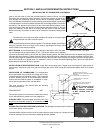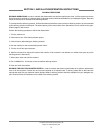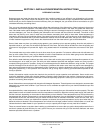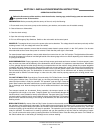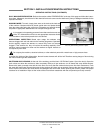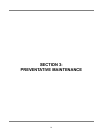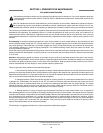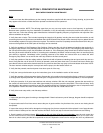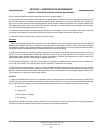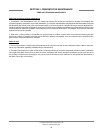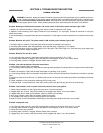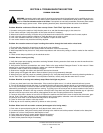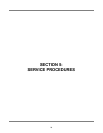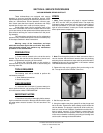
JFT Series Technical Manual 7610-002-77-38
Issued: 03-16-2006 Revised: N/A
28
SECTION 4: TROUBLESHOOTING SECTION
COMMON PROBLEMS
WARNING: Inspection, testing and repair of electrical equipment should be performed only by qualified service per-
sonnel. Certain procedures in this section require electrical tests or measurements while power is applied to the
machine. Exercise extreme caution at all times. If test points are not easily accessible, disconnect power, attach
test equipment and reapply power to test. When replacing electrical parts, disconnect power at source circuit breaker.
Problem: Machine continues to fill and does not stop. Green “Tank Filled” light does not come on.
1. No water coming to the machine. Verify that the power is on and that the water supply is also turned on.
2. Drain valves are open. Verify the position of the valves and shut if necessary.
3. Water level controls are faulty. Verify the wiring of the water level controls to the schematic and if correct, replace.
4. Leak in the tub. Inspect under the machine to verify that there are no holes or cracks.
5. Drain valve indicates closed but in reality is not. Replace or repair the drain valve.
6. Level control sensors may need the sensitivity adjusted.
Problem: An excessive amount of vapor is exiting the machine through the load and/or unload ends.
1. Ensure that the exhaust fan is turned on as well as the room ventilation.
2. Verify the correct placement of the curtains within the machine. Correct as necessary.
3. Water temperatures may be too hot. Verify water temperatures and ensure they comply to what is marked on the machine
data plate.
4. Check correct damper positioning in the electrical section.
Problem: Ware is coming out dirty.
1. Verify that proper pre-scrapping procedures are being followed. Allowing excessive food waste to enter the machine dimin-
ishes the cleaning capabilities.
2. Verify that the chemical concentrations are correct. Refer to the page entitled “Detergent Control” in this manual. If there
appears to be a problem with the chemicals, contact your chemical representative.
3. Prewash, wash or power rinse nozzles are clogged.
4. Strainers are clogged with debris and should be removed and cleaned.
5. Wash pumps are clogged with debris. Remove debris if pump is not permanently damaged.
6. Water level is too low and pumps are cavitating (drawing in air). Verify that water levels are correct by observing whether or
not the “Tank Filled” light is illuminated. If so and problem continues, visually verify that the water level is correct.
Problem: Machine is running and suddenly stops. Motor fault light may be on.
1. Power may have been lost to the dishmachine. If the control box lights are on, it is safe to assume that there is power.
2. Turn off the machine and open the doors. It is possible that the conveyor track became bound up or jammed during opera-
tion. It may be necessary to remove all ware from the conveyor rack before proceeding. Ensure there are no obvious jams or
obstructions preventing the conveyor belt from moving. Try pulling up on the conveyor belt at various locations in the event it
became misaligned. be careful, this may cause the conveyor belt to snap back into place instantly! Another sign of a jammed
belt will be the conveyor drive motor will be pulled against the unit and it’s spring bracket will be compressed.
3. Conveyor drive chain is broken or has come off. Secure the machine and remove the cover to expose the drive motor, gear-
ing and chain. If the chain is broken, it may be possible to put it back together, otherwise a new one should be ordered.
4. Conveyor drive motor could be faulted and may need to be replaced.
5. Failure of drive motor switch or slide stop switch.
6. Slide stop at end of machine pushed in by dishes on racks (normal).
Problem: Water level will not remain constant (tanks appear to be losing water).
1. Drain valve is open and draining the tub. Verify that all drain valves are shut.
2. Low water pressure. Verify that incoming water is flowing to the machine and at the pressure indicated on the data plate.
3. Machine is not level. Verify that the dishmachine is level.
4. Faulty water level control or control probe. Replace as required.
5. Check placement of splash shield runoffs. Adjust if necessary.
6. Check curtain placement. Adjust if necessary.



